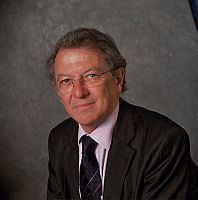Friday, April 19, 2024
News and Views from the Global South
Q&A: "Humans Are Now the Primary Drivers of Our Climate"
Interview with climate expert Sir David King
- Humanity faces enormous challenges at the start of the 21st century, says Sir David King, Britain's former chief scientific advisor and now director of the Smith School of Enterprise and the Environment at Oxford University in England.
The Forum, known as ESOF, is a biannual gathering of scientists, researchers, policy makers and journalists that has become Europe's largest scientific showcase. This year, 4,700 people registered for the five-day conference in Barcelona from Jul. 18- 22.
In his role as chief scientific advisor, Sir David was outspoken in his warnings to political leaders that climate change is a far greater threat than terrorism and that the failure to reduce emissions from burning fossil fuels would make terrorism far worse and create millions of environmental refugees.
IPS environmental correspondent Stephen Leahy spoke to Sir David at the symposium in Barcelona.
IPS: Population growth rates are slowing, what is your concern?
DK: Growth rates are beginning to slow. There are 6.8 billion people now and that will rise to 8 billion in 2028 and then peak at 9 billion in 2050, according to recent projections. However, that number of people will exert an impossible strain on the Earth's natural resources.
For example, there isn't enough fresh water for more than 8.5 billion people at our current average usage. Food production is limited by water availability and the only way forward will be to use genetic modification to create drought-tolerant crops. We here in Europe need to change our minds on GM crops. Those anti-GM attitudes probably crippled research and are responsible for a large number of hunger fatalities in Africa.
IPS: What about the current global food crisis?
DK: Fifty to 70 percent of the increase in food prices is driven by U.S. policy of subsidising biofuel production, specifically corn ethanol. That policy was all about reducing U.S. dependency on foreign oil imports and subsidising U.S. farmers. It was not about combating climate change. Brazil's sugarcane ethanol production is a biofuel that is effective in reducing emissions.
IPS: How much do we have to reduce global emissions of carbon dioxide (CO2) to reduce our risk of catastrophic climate impacts?
DK: Global emissions must be cut 50 percent by 2050 as the leaders of the G8 [Group of Eight – Canada, France, Germany, Italy, Japan, Russia, Britain, and the United States] agreed to in Hokkaido, Japan. I think that is an important step forward and applaud the leaders of the G8 countries.
IPS: Why is 50 percent by 2050 so important?
DK: Reaching that target should keep atmospheric CO2 concentrations around 450 parts per million. Pre-industrial concentrations averaged between 200 and 260 over the past 400,000 years. Current concentration is 387 ppm which means there won't be an ice age any time soon, and we were due for one about now. The last time CO2 was this high was 3 million years ago.
IPS: Do you mean we stopped the next ice age?
DK: In the past, when CO2 levels fell towards 200 ppm, it triggered an ice age because CO2 acts like a duvet blanket trapping heat. The thicker the duvet, the more heat is trapped. At 387 ppm so much heat is trapped the Arctic ice is melting along with the big ice-sheets in Greenland and Antarctica. Humans are now the primary drivers of our climate.
IPS: So peaking at 450 ppm is a good thing?
DK: It is probably the best we could hope to do. Even at 450 we have less than a 50 percent chance of keeping the global average temperature increase [to less than] 2 degrees C. We've already increased 0.8 C and seen many impacts, we still have 1.2 degrees C to go. There is also a 20 percent chance at 450 ppm temperatures will exceed 3.7C, a dangerous level of climate change. I'd much prefer to be at 350 ppm where there is a very low risk.
IPS: How can we reach and stay at 450 ppm, the so-called climate stabilisation scenario?
DK: It can mostly be achieved with existing technologies involving a combination of improvements in energy efficiency and wide-scale use of renewable energy, nuclear energy, carbon capture and storage and so on. In the United Kingdom, all new buildings must have a zero carbon footprint by 2018. That means buildings will actually have to generate green energy to offset the carbon emitted during their construction.
IPS: What about at the global level; what has to happen there and especially at the crucial United Nations climate summit next year in Copenhagen?
DK: In Copenhagen, we need every country to agree to the 50 [percent reduction] by 2050 target. And then we have to agree on national targets where developed nations cut their emissions rapidly and less developed cut theirs more gradually, perhaps after reaching a peak in the near future. We will also need agreement on a global carbon cap and trade system where countries that fail to curb their emissions will have to pay. Copenhagen is the most important opportunity for climate change in the next five years.
IPS: You're strongly in favour of GM crops and nuclear energy, that's not a typical European environmentalist, is it?
DK: I'm no tree hugger.

 Print
Print




